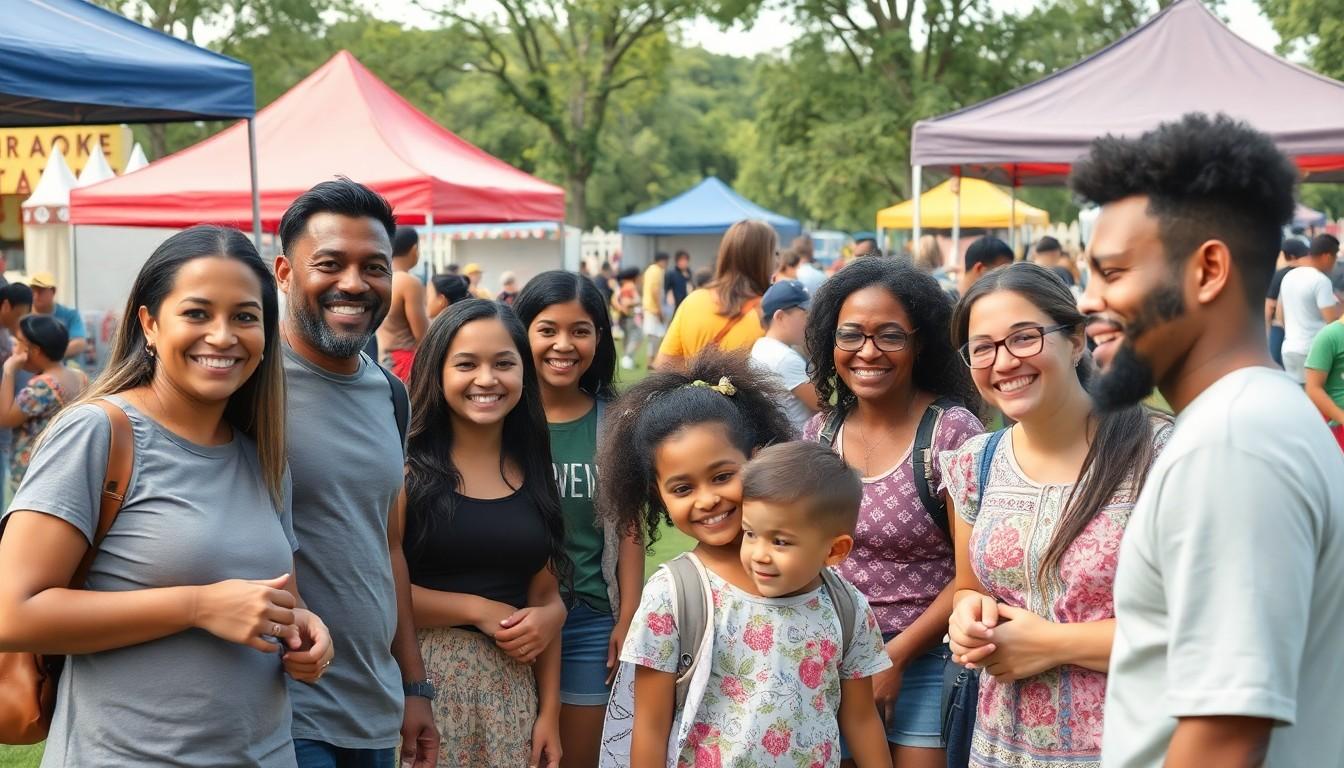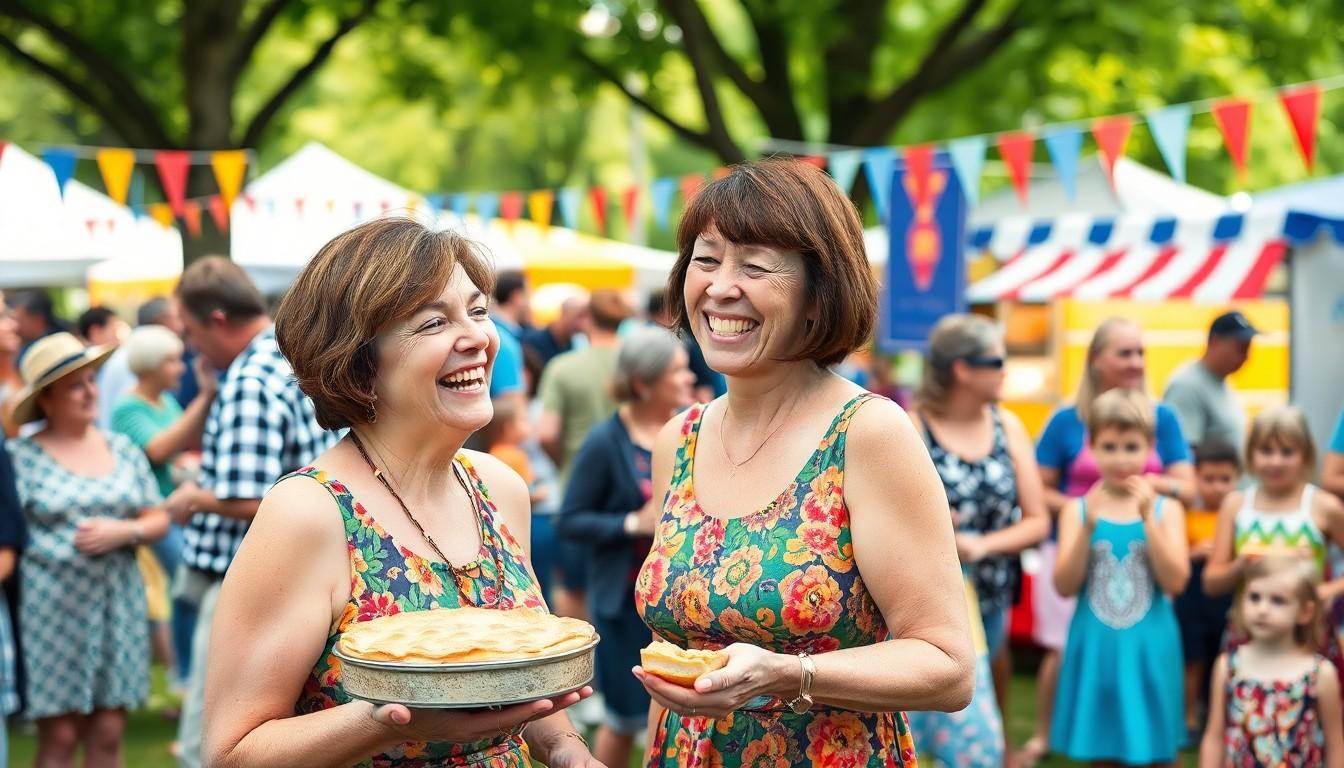Community events are the heartbeat of neighborhoods, bringing people together in ways that make even the most introverted neighbor crack a smile. From quirky festivals to heartwarming charity runs, these gatherings create connections that transform a simple block into a vibrant tapestry of camaraderie. Who knew that a pie-eating contest could spark friendships that last a lifetime?
community events examples
Community events come in various forms, each serving unique purposes and fostering different connections among residents.
Cultural Festivals
Cultural festivals celebrate diversity and heritage within communities. Attendees can immerse themselves in different cuisines, music, and traditions. These events often include performances, art displays, and workshops. They encourage people to learn about various cultures, promoting tolerance and understanding. For example, a local cultural festival might showcase food vendors offering ethnic dishes, dance troupes performing traditional routines, and artists exhibiting their crafts. Such engagements create opportunities for dialogue and shared experiences, ultimately enriching community life.
Charity Runs
Charity runs unite participants for a common cause, combining physical activity with philanthropy. Individuals may register to run or walk distances such as 5K or half-marathons. Funds raised typically support local charities, schools, or health initiatives. Along the route, volunteers often provide encouragement and refreshments. These events not only improve health and wellness but also foster camaraderie among participants. For instance, a charity run in the community could focus on raising money for cancer research, encouraging local businesses to sponsor the event and contribute to the cause.
Farmers’ Markets
Farmers’ markets offer residents fresh produce and goods directly from local growers. Vendors often display fruits, vegetables, baked items, and handmade crafts. Engaging with farmers fosters relationships while supporting the local economy. Regular visits can also promote healthy eating habits within the community. A typical farmers’ market may feature live music, cooking demonstrations, and children’s activities, transforming shopping into a vibrant community experience. Locals benefit not only from fresh products, but also from the connections formed with farmers and fellow shoppers.
Benefits of Community Events

Community events offer numerous advantages for neighborhoods, strengthening ties among residents while enhancing overall community life.
Fostering Connections
Connecting with neighbors occurs naturally at community events. These gatherings create spaces for interaction, allowing residents to engage and form friendships. Introverted individuals may find comfort among like-minded people during activities such as pie-eating contests or cultural festivals. Participants share experiences, fostering a sense of belonging that enriches community life. Regular attendance at events solidifies friendships, creating a supportive environment. Moreover, children benefit from these interactions by building social skills through varied group activities. Engaging in community events reinforces connections and provides a foundation for long-lasting relationships.
Boosting Local Economy
Local economies experience significant boosts from community events. Festivals and farmers’ markets attract visitors, increasing foot traffic for nearby businesses. Vendors showcasing products often report higher sales during events, which benefits the local economy directly. Collaborations between local organizations and businesses lead to increased funding opportunities, enhancing resources for future events. Job creation also occurs, as more staffing is required for these gatherings. Furthermore, events promote local products, encouraging residents to shop within their community. Supporting local economies through community events leads to a vibrant and sustainable neighborhood.
Planning Successful Community Events
Planning successful community events requires strategic thinking and active engagement. Establishing clear objectives guides the entire event process and contributes to its success.
Setting Objectives
Defining specific goals is crucial for effective planning. Objectives might include increasing community participation or raising funds for local causes. Setting measurable targets ensures accountability and helps track progress. For instance, aiming for a 20% increase in attendance compared to last year’s festival creates a clear benchmark. Prioritizing stakeholder input strengthens the event’s purpose, resonating with the community’s needs and interests. Gathering feedback through surveys allows organizers to refine objectives, making events more relevant and impactful.
Engaging the Community
Engagement starts with effective outreach. Utilizing social media platforms and local newspapers helps spread awareness about upcoming events. Hosting brainstorming sessions invites community members to share their ideas, fostering a collaborative atmosphere. Creating volunteer opportunities enables residents to take part in planning and execution, increasing ownership over the event. Building partnerships with local businesses and organizations can enhance resources and expertise. Attending existing community meetings also allows organizers to amplify event visibility and strengthen relationships. Encouraging participation through incentives, such as contests or discounts, promotes excitement and encourages attendance.
Promoting Community Events
Promoting community events requires effective strategies to ensure maximum engagement and participation.
Utilizing Social Media
Social media platforms serve as powerful tools for promoting community events. Engaging posts about upcoming events can reach a broader audience, drawing in both residents and visitors. Creating event pages on Facebook invites community members to RSVP and share with friends. Twitter serves as an excellent channel to provide real-time updates, such as weather changes or activity highlights. Visual content on Instagram showcases event activities, making it more appealing and shareable. Consistent use of relevant hashtags increases visibility and participation. Interactive stories, polls, and countdowns on platforms like Instagram engage users, keeping the event top of mind.
Collaborating with Local Businesses
Collaboration with local businesses enhances the promotion of community events. Local shops can display flyers and offer promotions that align with event themes, generating mutual benefits. Partnering with businesses for sponsorship provides financial support and resources, enhancing the overall event experience. Joint advertising in local newspapers and on social media extends outreach, ensuring more residents are aware. Establishing a presence at local businesses creates a two-way dialogue, encouraging them to share event details with customers. Such collaborations can even showcase local products, fostering a sense of community pride and ownership in the events.
enhancing neighborhood life
Community events are essential for nurturing connections and enhancing neighborhood life. By bringing residents together through various activities, these gatherings create opportunities for friendships and collaboration. Whether it’s a cultural festival or a charity run, each event serves a unique purpose that strengthens community ties.
The impact of these events extends beyond social interactions. They stimulate local economies and provide platforms for local businesses to thrive. As communities continue to embrace these gatherings, they foster a sense of belonging and collective identity. Engaging in community events not only enriches individual lives but also contributes to a vibrant and sustainable neighborhood.

